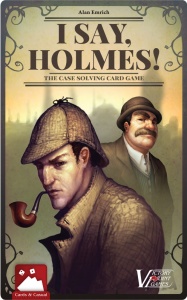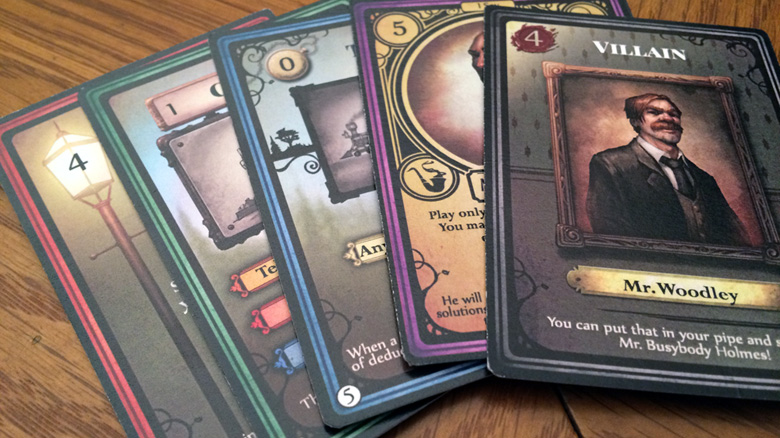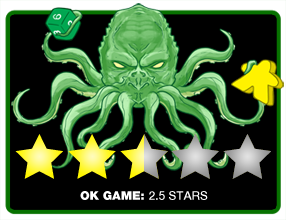 When I first started to read books there was one series I loved, Encyclopedia Brown. The books were a collection of short mysteries that were intended for the reader to solve due to some logical or factual inconstancy. This started my love of mystery novels and television shows, which of course lead me to reading Sir Arthur Doyle’s Sherlock Holmes collection. Even though I love the deduction element of these types of stories, I didn’t have any game with that theme or mechanic until I got a copy of Victory Point Games’ second edition of I Say, Holmes!. I Say, Holmes! is a card game where players take on the role of Consulting Detectives, playing cards to progress Holmes’ and Watson’s story. Will this game become the gaming equivalent of “The Hound of the Baskervilles”? Read on to find out!
When I first started to read books there was one series I loved, Encyclopedia Brown. The books were a collection of short mysteries that were intended for the reader to solve due to some logical or factual inconstancy. This started my love of mystery novels and television shows, which of course lead me to reading Sir Arthur Doyle’s Sherlock Holmes collection. Even though I love the deduction element of these types of stories, I didn’t have any game with that theme or mechanic until I got a copy of Victory Point Games’ second edition of I Say, Holmes!. I Say, Holmes! is a card game where players take on the role of Consulting Detectives, playing cards to progress Holmes’ and Watson’s story. Will this game become the gaming equivalent of “The Hound of the Baskervilles”? Read on to find out!
I Say, Holmes! is a card game for 3-8 players that plays in under forty-five minutes. In my experience, the game plays best with five or more people.
Game Overview:
I Say, Holmes! is a game that allows each player to add to a new Sherlock Holmes mystery. Players will have a set of cards that will give them information, travel to different locations, gain help from famous Holmes characters and even villain cards. Players will have two primary objectives in the game. They need to find out who has a villain card in their hand and arrest them to end the round. Any player who has a villain card will be trying to elude the detectives long enough to escape into the night. On a player’s turn, he will look at the previous card played and have to play a card from their hand that matches the suitable story sequence on that card. Players will earn points for solving cases, escaping as villains or gaining other tokens through the game. The person that has the most points at the end of the game wins.
Components:

The game is published by Victory Point Games and if you ever purchase a game they produce, you have to know what you are getting into components wise. The tokens need to be cleaned around the edges but they provide a napkin that works surprisingly well. After taking the soot off the tokens, they look fantastic. Very thick and hold up well. Part of the Kickstarter project that allowed this game to be put back into production was for a new process to improve the quality of the cards. Unfortunately, I received a copy before these were included in the game, so I can’t speak to their quality. I can tell you that the updated artwork is awesome. It has a Victorian feel that transports you to that time as you look at the cards. In addition, they each have a quote or line from a Holmes story. I also want to mention how much I like the iconography on the cards. They have boxes that show what type of card can be played by the next person. It clear and colorful, allowing players to quickly establish what card they need to play. Each type of card has a different color border making sorting them a breeze.
How to Play:
The game starts with players combing through the deck looking for all cards that have a number equal or less than the number of players in the game on the bottom left corner of the cards. This creates a starting deck and allows for a balanced distribution of cards in the first round of the game while making sure there is at least one villain card in someone’s hand at the start of the round.
The player that was dealt “The Game is Afoot” card will start the game by placing it in front of the person to their left. This person will look at the card to see which cards they are required to play on their turn. For the first card in the game, the player is required to play any travel card. This card is placed in front of the person to their left. If they can’t, they must draw a card from the deck. If this card is playable, they must play it. If it isn’t playable, the card on the table moves from the current player to the player on their left who will try to continue the story. This will continue until either an arrest has been made or a villain has escaped. I want to explain the cards more before I get into end of round scoring.

Players may also play an “I, Say” card, which all have an iconic character from the Holmes stories, out of the story sequence. These cards have special actions that will allow you to manipulate the story and affect you or the other players. All cards except for villain, travel, and location cards, will have some other effect on the game. They can allow you to force a player to draw more cards, swap hands, peak at a few cards or give yourself an alibi when someone tries to arrest you. All of them are valuable at certain times of the game if you can get them in play.
If a player has only interrupt and villain cards left in their hand at the start of their turn, they will end the round. That player will take the villain token that matches the one in their hand and it will be worth points at the end of the game. A round can end in an arrest in two ways, either by a player playing an arrest card or by an impromptu arrest. If a player has gotten rid of all their cards, they can accuse someone of being a villain. If the accuser happens to be wrong, they take all the cards from the player they accused and that person now draws three cards. Once an accused player has a villain card in their hand and can’t stop the arrest, the round ends. All players will then total the case point value on all the cards in their hands. That total will determine which case book token they will be able to claim with the ones requiring a higher case value being worth more points.
The game will end when a person is forced to take the “His Last Bow” case token, either because the case value is low enough or all of the other tokens are taken. Everyone will tally all of the tokens and the highest point total wins.

Game Experience:
Two things drew me to this game, theme and player count. Let’s deal with the later first. I was excited to find a game that I could play with a larger group, one of the more difficult things to do in gaming. The game succeeds well at the higher player count. It gets more cards out of the deck and into player’s hands. This allows for a greater opportunity for players to draw a villain and I, Say cards that are some of the most fun to play in the deck.

As for theme, the game has it in spades. As I said in the component section, the art direction is spot on. As you shuffle through the images on the cards, they look like locations you expect that Sherlock Holmes visited attempting to solve crimes in the books. In addition, the whole game revolves around telling a Holmes mystery. While you play these cards, you are creating that case. The story transports you to a countryside location where a piece of evidence leads you to travel back to the city to visit Scotland Yard. When you string all of the cards together, they form this interesting story.
The iconic characters and quotes from the stories help develop the story of each case even more. They give gravity and connect to each location, action, or travel that you do during the game. I feel that it is one of the strongest thematic games I have ever played. The game play in I Say, Holmes! is very easy to teach. It does take some time to learn the rulebook, so you can make sure teaching new players is as efficient as possible by reading ahead of time. The game does do a good job at explaining everything, just not as concise as I would like it. Unfortunately, the actual game play was a letdown compared to the strength of the theme.
At the core, I like the idea of the mechanics in the game. The idea of playing cards to develop a story as well as gathering pieces of information to figure out the who holds a villain card intrigues me. The game also plays differently when you are holding the villain cards. You try to discard down to allow you to escape and being sneaky about that process can be fun. The reason this potential falls flat is that, as a player, I have very little control over how I play my hand.

Players are always bound to the set of suits on the card played previously. I do like how the I, Say cards allow you to break that sequence and play whenever you would like. These are essentially wild cards that help throw variance into the story, but there are not enough of them to make a significant impact. This leads to moments in the game when you know another player has a villain card and you hold an arrest card. However, turn after turn, the person to your right plays a card that doesn’t allow you to take advantage of that information. If you are having flashbacks to games of Uno, you know how I’m feeling. This ridged gameplay also leads to times when you will go around the table a few times before anyone can draw a card to continue the story. This leads to inconsistent pacing in the game, which doesn’t sit well with some.
When everyone is playing cards that force action, the game is extremely fun. You are establishing new information, swapping cards, accusing people, and that keeps the game interesting. It’s that lull in action that makes the experience suffer. It makes sense that this would happen from a story perspective, that the trail had turned cold. However, this doesn’t mean that players should have to suffer through that slow down in the game.
Final Thoughts:
I think I Say, Holmes! is one of the most conflicted reviews I have ever written. On one hand, if you enjoy the theme of solving a mystery alongside Sherlock Holmes, the theme will grab you. The artwork, iconic locations and characters, and even the quotes from books will suck you into the story of solving this mystery. Sadly, the game play is inconsistent in its pacing. The idea of requiring the right cards to continue the story works for the theme, but can cause frustration as you attempt to solve the crime or escape the city.
I Say, Holmes! is full of fun moments as you accuse a person or are close to escaping, but the combination of game play with story causes the overall game pacing to suffer. I still think I Say, Holmes! can have a place in your collection if you like the mystery theme. It plays well with higher player counts and if you just play it for a case or two, the experience can be a good one.
If you’d like to get a copy for yourself, you can pick up copy for about $35.
Final Score: 2.5 Stars – A game with a strong theme, but overall game play suffers as you are forced to follow the story rather than choosing your own path to solve the crime.
 Hits:
Hits:
• Strong theme throughout the game
• Fun elements when they happen
• Great artwork
Misses:
• Pacing issues
• Lack of flexibility to decide how you will play your cards
• Frustrating moments as you can’t always act on knowledge






















